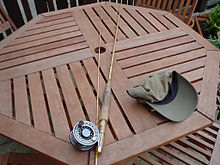
Fishing is the activity of trying to catch fish. Fish are often caught as wildlife from the natural environments, but may also be caught from stocked bodies of water such as ponds, canals, park wetlands and reservoirs. Fishing techniques include hand-gathering, spearing, netting, angling, shooting and trapping, as well as more destructive and often illegal techniques such as electrocution, blasting and poisoning.

A fishing rod is a long, thin rod used by anglers to catch fish by manipulating a line ending in a hook. At its most basic form, a fishing rod is a straight rigid stick/pole with a line attached to one end ; however, modern rods are usually elastic and generally have the line stored in a reel mounted at the rod handle, which is hand-cranked and controls the line retrieval, as well as numerous line-restricting rings that distribute bending stress along the rod and help dampening down/prevent line whipping and entanglement. To better entice fish, baits or lures are dressed onto the one or more hooks attached to the line, and a bite indicator is used, some of which might be incorporated as part of the rod itself.
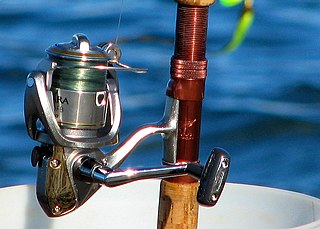
A fishing reel is a hand-cranked reel used in fishing to wind and stow fishing line, typical mounted to a fishing rod, but may also be used to retrieve a tethered arrow when bowfishing.

Fly fishing is an angling method that uses a light-weight lure—called an artificial fly—to catch fish. The fly is cast using a fly rod, reel, and specialized weighted line. The light weight requires casting techniques significantly different from other forms of casting. The flies may resemble natural invertebrates, bait-fish, or other food organisms.
Orvis is an American family-owned retail and mail-order business specializing in fly fishing, hunting and sporting goods. Founded in Manchester, Vermont, in 1856 by Charles F. Orvis to sell fishing tackle, it is the oldest mail-order retailer in the United States.
Luis Marden was an American photographer, explorer, writer, filmmaker, diver, navigator, and linguist who worked for National Geographic Magazine. He worked as a photographer and reporter before serving as chief of the National Geographic foreign editorial staff. He was a pioneer in the use of color photography, both on land and underwater, and also made many discoveries in the world of science.

Fishing tackle is the equipment used by anglers when fishing. Almost any equipment or gear used in fishing can be called fishing tackle, examples being hooks, lines, baits/lures, rods, reels, floats, sinkers/feeders, nets, stringers/keepnets/livewells, spears, gaffs, traps, waders and tackle boxes, as well as any wire, snaps, beads, spoons, blades, spinners, clevises and tools that make it easy to tie knots.
Fly rod building is the art of constructing a fly fishing rod to match the performance desires of the individual angler. Fly rods are usually made of graphite or cane poles. There are several commercial manufacturers of fly rods, including Echo, Hardy, Zephrus, G. Loomis, Orvis, Reddington, Sage, Scott, St. Croix, Temple Fork Outfitters, and R. L. Winston; however, many individuals make fly rods for personal pleasure or profit.
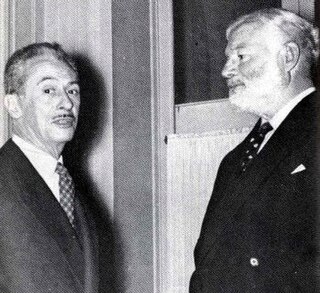
Charles C. Ritz was a French hotelier and fly fishing specialist.
Fly fishing tackle comprises the fishing tackle or equipment typically used by fly anglers. Fly fishing tackle includes:

Tenkara fishing is a type of simple rod angling traditionally practiced in Japan. Primarily used for mountain stream trout fishing, tenkara is still a fairly rare method even among freshwater anglers in Japan, and was largely unknown outside Japan until 2009, when the company Tenkara USA, founded by Daniel Galhardo, introduced and popularized tenkara outside Japan.
Henry Milward & Sons is an English manufacturer of sewing needles based in Redditch. Henry Milward and Sons and its employees boast over a quarter of a millennium making needles.
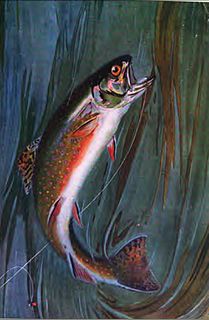
This annotated bibliography is intended to list both notable and not so notable works of English language, non-fiction and fiction related to the sport of fly fishing listed by year published. Although 100% of any book listed is not necessarily devoted to fly fishing, all these titles have significant fly fishing content. Included in this bibliography is a list of species related fly fishing literature.
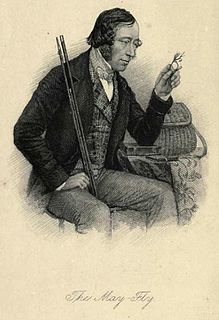
This annotated bibliography is intended to list both notable and not so notable works of English language, non-fiction and fiction related to the sport of fly fishing listed by year published. Although 100% of any book listed is not necessarily devoted to fly fishing, all these titles have significant fly fishing content. Included in this bibliography is a list of fly tying, fly tackle, regional guides, memoirs, stories and fly fishing fiction related literature.
Oyster Fly Rods is a bamboo fly rod making business in Blue Ridge, Georgia. It belongs to famous fly fisherman Bill Oyster, who makes "every one" of the forty custom rods produced each year by hand, as well as a few standardized rods. He described the process as: "I split each twelve-foot length of cane into six strips... Then, depending on the length, number of pieces, and action wanted, I plane each strip of cane to thousandths of an inch. I also engrave all the nickel and silver hardware, which takes as long as the actual creation of the rod." The rods have fast action, include distinctive engravings, "elegant" rattan grips, and are "remarkably fishable". Oyster Fly Rods was a winner in the "Sporting" category of Garden & Gun magazine's "Made in the South" 2010 competition.
Edmund Everett Garrison was a structural and electrical engineer known as a maker of bamboo fly rods and co-author of A Master's Guide To Building A Bamboo Fly Rod. Everett Garrison's methods and designs have been utilized by generations of bamboo fly rod makers. His rods fetch high prices from collectors.

Bunyan Bugs are a series of synthetic objects used as fly rod bait in fly-fishing, designed to look like a wide variety of insects, including grasshoppers, stoneflies, Mayflies, horse flies, bumble bees, ants and caddisflies.
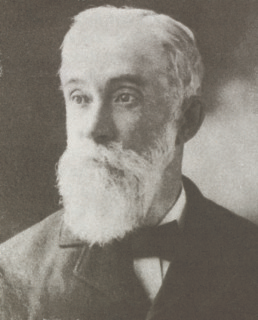
Hiram Lewis Leonard, was the founder of the H.L. Leonard Rod Company. He has been regarded as the father of the modern fly rod. He was also an adventurer, gunsmith, engineer and maker of musical instruments. His exploits as a guide and hunter were written about by Henry David Thoreau. As an innovator in bamboo fly rod construction, manufacture and performance, the rodmakers Leonard trained went on to become leaders in the field of bamboo rodmaking. The rods bearing his name are sought after for their aesthetics, performance and as collectables.
Eustis William Edwards was best known as a premier bamboo fly rod maker and innovator. During his time, the fly rods he made were considered the best of their kind. He worked for H.L. Leonard, co-created the Kosmic Rod, produced fly rods under his own name and manufactured them for the large sporting goods companies. His contributions were crucial in the creation of what today we regard as the 'modern fly rod'.
Paul Holden Young was a master bamboo fly rod maker, fly tyer and fly fishing innovator. The work of Paul Young is greatly admired by anglers and collectors today.
